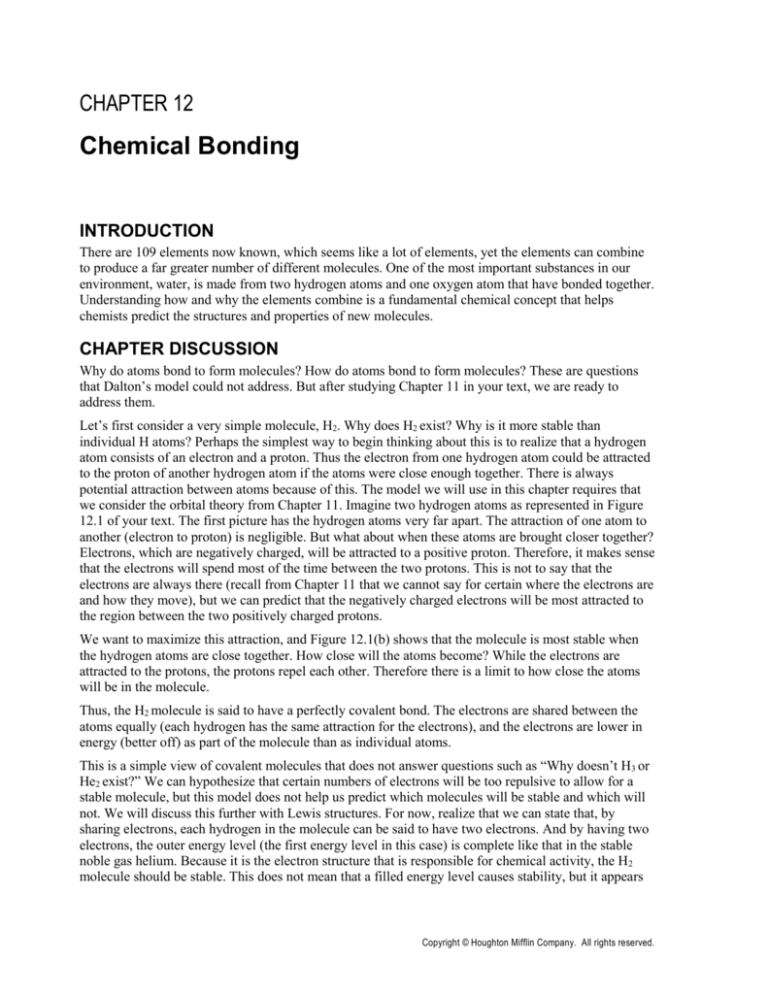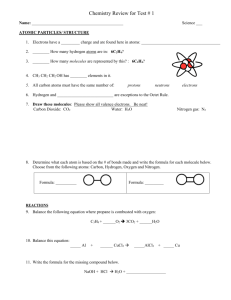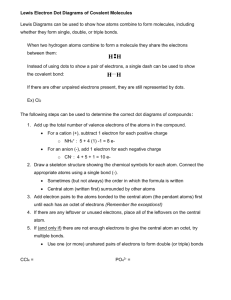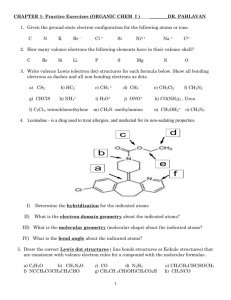
CHAPTER 12
Chemical Bonding
INTRODUCTION
There are 109 elements now known, which seems like a lot of elements, yet the elements can combine
to produce a far greater number of different molecules. One of the most important substances in our
environment, water, is made from two hydrogen atoms and one oxygen atom that have bonded together.
Understanding how and why the elements combine is a fundamental chemical concept that helps
chemists predict the structures and properties of new molecules.
CHAPTER DISCUSSION
Why do atoms bond to form molecules? How do atoms bond to form molecules? These are questions
that Dalton’s model could not address. But after studying Chapter 11 in your text, we are ready to
address them.
Let’s first consider a very simple molecule, H2. Why does H2 exist? Why is it more stable than
individual H atoms? Perhaps the simplest way to begin thinking about this is to realize that a hydrogen
atom consists of an electron and a proton. Thus the electron from one hydrogen atom could be attracted
to the proton of another hydrogen atom if the atoms were close enough together. There is always
potential attraction between atoms because of this. The model we will use in this chapter requires that
we consider the orbital theory from Chapter 11. Imagine two hydrogen atoms as represented in Figure
12.1 of your text. The first picture has the hydrogen atoms very far apart. The attraction of one atom to
another (electron to proton) is negligible. But what about when these atoms are brought closer together?
Electrons, which are negatively charged, will be attracted to a positive proton. Therefore, it makes sense
that the electrons will spend most of the time between the two protons. This is not to say that the
electrons are always there (recall from Chapter 11 that we cannot say for certain where the electrons are
and how they move), but we can predict that the negatively charged electrons will be most attracted to
the region between the two positively charged protons.
We want to maximize this attraction, and Figure 12.1(b) shows that the molecule is most stable when
the hydrogen atoms are close together. How close will the atoms become? While the electrons are
attracted to the protons, the protons repel each other. Therefore there is a limit to how close the atoms
will be in the molecule.
Thus, the H2 molecule is said to have a perfectly covalent bond. The electrons are shared between the
atoms equally (each hydrogen has the same attraction for the electrons), and the electrons are lower in
energy (better off) as part of the molecule than as individual atoms.
This is a simple view of covalent molecules that does not answer questions such as “Why doesn’t H3 or
He2 exist?” We can hypothesize that certain numbers of electrons will be too repulsive to allow for a
stable molecule, but this model does not help us predict which molecules will be stable and which will
not. We will discuss this further with Lewis structures. For now, realize that we can state that, by
sharing electrons, each hydrogen in the molecule can be said to have two electrons. And by having two
electrons, the outer energy level (the first energy level in this case) is complete like that in the stable
noble gas helium. Because it is the electron structure that is responsible for chemical activity, the H2
molecule should be stable. This does not mean that a filled energy level causes stability, but it appears
Copyright © Houghton Mifflin Company. All rights reserved.
Chapter 12: Chemical Bonding
109
to be related to stability. Like all models, this is a simplification, but it is a good way to first start
thinking about molecules.
We have considered a molecule with two of the same atoms. What about the other end of the spectrum?
That is, what about a molecule with two very different atoms? For example, what about sodium
chloride (NaCl)? At first it seems reasonable to think of this molecule in the same way as we did with
H2. That is, there should be an attraction between these atoms because of the attraction between the
electrons and protons. Thus we might be tempted to represent the molecule in the same way we did H2.
However, in the case of H2, the hydrogen atoms exhibited equal attraction for the electrons. This is not
true between sodium and chlorine. It turns out that chlorine has a much greater attraction for electrons
than does sodium (we will consider this later). Thus, instead of the electrons being shared between the
atoms, it is actually the case that ions are formed. An electron will be transferred from the sodium atom
to the chlorine atom. We should represent the sodium chloride molecule like Figure 12.4(c) in your text.
This is known as an ionic bond.
These are what we might call the two extreme cases. In the first case electrons were perfectly shared,
and in the second case an electron was transferred from one atom to another. But what about
intermediate cases? For example, consider the CO (carbon monoxide) molecule. While these atoms will
not share electrons equally, the difference in their attraction for electrons is not so great that an electron
will be transferred. In this case, the oxygen has more attraction for the electrons than does carbon.
There is therefore a greater probability of finding an electron nearer the oxygen than the carbon. This
can be represented like in Figure 12.4(b) of your text. Note that this molecule has partial positive and
partial negative regions (not as extreme as ions, but not perfectly covalent either). This is termed a
dipole moment, and the bond is considered polar covalent. It is covalent because electrons are shared
but polar because the sharing is unequal and leads to partial charges.
It is best to think of bonding as a continuum, not as three separate types. That is, the more alike the
atoms are with respect to attraction for electrons, the more covalent the bond is; the more different they
are, the more ionic the bond is. This is represented in Table 12.1 of your text.
This brings about another trend called electronegativity, which is the attraction an atom in a molecule
feels for a shared electron. This is discussed in detail in Section 12.2 of your text. As with atomic radii
and ionization energy trends from Chapter 11, make sure to understand these trends, not merely
memorize them.
Now that we have a better understanding of chemical bonds, we can go on to other questions. For
example, can we predict that H2O is a stable molecule? We know that water (H2O) is stable, but can our
model support this? And can it lead us to better understand the properties of water? The answer to both
of these questions is yes.
The Localized Electron Model
At this point we would like to show how the electrons (outer shell or valence electrons) are arranged in
the molecule and to describe the geometry of the molecules (which is an important function of the
properties of the molecule).
To do this we will use a very simple model called the localized electron model. This model, like all
models, is a simplification, but it serves to answer our questions and make correct predictions and is
relatively simple to use. In this model, we assume that we know where the electrons in a molecule are
located. Recall that we predict the electrons in a covalent bond will spend a great deal of time between
atoms. Therefore, we assume that the electrons are fixed (localized) between the atoms. Again, these
are simplifications, but they serve our purposes. Also, we assume that electrons will be shared in a
molecule so that the individual atoms will have eight electrons (known as the octet rule) with the
Copyright © Houghton Mifflin Company. All rights reserved.
110
Chapter 12: Chemical Bonding
exception of hydrogen, which will have two electrons. There are some exceptions to this (as always)
but these general guidelines work surprisingly well.
Sections 12.6 and 12.7 provide good guidelines for drawing Lewis structures, which show how the
valence electrons are distributed in the molecule. There are also many examples of these, along with
notable exceptions, so we will not belabor the point here. Becoming proficient at drawing Lewis
structures requires practice. But make sure you also understand what the Lewis structures represent (as
described above).
From Lewis structures we can determine the geometry of the molecules using the VSEPR model.
Again, this model is quite simple but works well. The basic premise is that the electron pairs (both
bonding and lone pairs) repel each other, and the geometry is a direct result of minimizing the
repulsions between these electron pairs. Table 12.4 gives a nice overview of these geometries, along
with example molecules.
You must draw the Lewis structure before you can determine the geometry of the molecule because the
lone pairs do affect the geometry. For example, note in Table 12.4 the molecules BF3 and NH3. Both of
these molecules seem similar from their formulas. However, they have different geometries because
they have different Lewis structures.
LEARNING REVIEW
1.
What are the two kinds of bonds that can form between atoms?
2.
What kind of bond forms between
a.
two identical atoms?
b.
a metal and a nonmetal?
3.
What is meant by a polar covalent bond?
4.
Which of these choices has an ionic bond?
5.
a.
CO
b.
CaBr2
c.
HBr
d.
Cl2
Arrange the following atoms based on electronegativity. Put the most electronegative atom on the
right and the least electronegative atom on the left.
P
6.
7.
Al
Cl
Mg
Which bond is the most polar? Which bond is the least polar?
a.
P–Cl
b.
H–H
c.
N–H
d.
C–F
Write electron configurations for both reactants and products for the reactions below.
a.
Mg + Cl2 Mg2+ + 2Cl−
b.
2Li + S 2LI+ + S2−
Copyright © Houghton Mifflin Company. All rights reserved.
Chapter 12: Chemical Bonding
111
8.
When two nitrogen atoms combine to form a nitrogen molecule, how many electrons are shared to
give each atom a complete octet?
9.
How many electrons do each of the atoms below need to gain, lose or share to achieve a noble-gas
valence electron configuration?
a.
S
b.
Mg
c.
C
10. In which of the atom/ion pairs is the ion smaller than the atom?
a.
S/S2−
b.
Ca/Ca2+
c.
Li/Li2+
d.
I/I−
11. Draw Lewis structures for these ionic compounds.
a.
MgS
b.
Na2O
12. Write valence electron configurations for the following atoms.
a.
B
b.
Sr
c.
Kr
d.
Cl
13. Draw Lewis structures for the molecules or ions below.
a.
H2S
b.
HCCH
c.
PO43−
d.
HI
e.
PCl3
14. Some molecules have Lewis structures that violate the octet rule. Draw a probable Lewis structure
for BeI2.
15. Use the VSEPR model to determine the molecular structure of each of the molecules below.
a.
SbF3
b.
BH3
c.
SiH4
d.
Copyright © Houghton Mifflin Company. All rights reserved.
112
Chapter 12: Chemical Bonding
ANSWERS TO LEARNING REVIEW
1.
When atoms combine they form either ionic bonds or covalent bonds. In an ionic bond, electrons
are completely transferred. In a covalent bond, electrons are shared between atoms. Ionic bonds
usually form when a metal and a nonmetal react. Covalent bonds usually form when two
nonmetals react.
2.
a.
When two identical atoms bond, a nonpolar covalent bond forms.
b.
When a metal and a nonmetal bond, an ionic bond forms.
3.
Electrons shared between two atoms are not always shared equally. Sometimes the electrons are
attracted to one of the atoms more than the other. The atom in a bond that attracts the electron pair
will have an extra electron part of the time and so bear a partial negative charge. The atom that
does not strongly attract the electron pair it shares will be electron-deficient part of the time and so
will bear a positive charge. The kind of covalent bond where the electrons are not shared equally
is called a polar covalent bond.
4.
Ionic bonds are formed when a metal loses an electron to a nonmetal. Among these choices, the
only bond between a metal and a nonmetal is the bond formed between calcium and bromine to
form calcium bromide. So the correct answer is b.
5.
Elements on the right side of the periodic table have higher electronegativity values than do
elements on the left side of the periodic table. The atom with the highest electronegativity would
be Cl because it is in the upper right-hand corner of the periodic table; then P, then Al, and Mg, on
the left side of the periodic table, is the lowest.
Mg
6.
Al
P
Cl
To determine the polarity of a bond, subtract the electronegativity of the least electronegative
atom from the electronegativity of the most electronegative atom. The largest difference is the
most polar bond, and the smallest difference is the least polar bond.
a.
P is 2.1 while Cl is 3.0. The difference is 0.9.
b.
Both H atoms are 2.1. The difference is 0.0.
c.
N is 3.0 while H is 2.1. The difference is 0.9.
d.
C is 2.5 while F is 4.0. The difference is 1.5.
The most polar of these bonds is the C–F bond because the difference in electronegativities is the
highest, 1.5. The least polar bond is that which is formed between two hydrogen atoms. The
difference in electronegativities is zero, which means that this bond is completely nonpolar.
7.
a.
Mg + Cl2 Mg2+ + 2Cl−
1s22s22p63s2 + 1s22s22p63s23p5 1s22s22p6 + 2(1s22s22p63s23p6)
b.
2Li + S 2Li+ + S2−
2(1s22s1) + 1s22s22p63s23p4 2(1s2) + 1s22s22p63s23p6
Copyright © Houghton Mifflin Company. All rights reserved.
Chapter 12: Chemical Bonding
8.
113
Nitrogen is in Group 5 of the periodic table, which means that it has five valence electrons. Most
elements obey the octet rule when they bond with other atoms, so a nitrogen molecule should be
composed of two nitrogen atoms, each with a complete octet. When two nitrogen atoms bond,
they can only achieve an octet by sharing six electrons, three from each nitrogen atom. So in a
nitrogen molecule each nitrogen atom has two valence electrons of its own and shares six with
another nitrogen atom.
9.
a.
Sulfur is in Group 6 of the periodic table, so it has six valence electrons. Sulfur needs two
more electrons to fill its valence shell. Sulfur often gains two electrons to become a sulfide
ion, S2−. The sulfide ion has the same electron configuration as argon.
b.
Magnesium is in Group 2 of the periodic table and has two valence electrons. Magnesium
atoms lose two electrons to form the Mg2+ ion. The magnesium ion has the same electron
configuration as neon.
c.
Carbon is in Group 4 of the periodic table, so it has four valence electrons. Each carbon
atom will share four valence electrons with other atoms. When a carbon atom shares four
electrons with other atoms, it has the same electron configuration as neon.
a.
The sulfide ion has gained two electrons, so it is larger than the sulfur atom.
b.
The calcium ion has lost two electrons, so it is smaller than the calcium atom.
c.
The lithium ion has lost one electron, so it is smaller than the lithium atom.
d.
The iodide ion has gained one electron, so it is larger than the iodine atom.
a.
In ionic compounds, the electrons lost from the metal are transferred to the nonmetal so that
each atom can achieve a noble-gas configuration.
b.
Two sodium atoms each lose one electron to an oxygen atom so that all three atoms achieve
a noble-gas configuration.
a.
B 2s12p1
b.
Sr 5s2
c.
Kr 4s24p6
d.
Cl 3s23p5
10.
11.
12.
Copyright © Houghton Mifflin Company. All rights reserved.
114
Chapter 12: Chemical Bonding
13.
a.
Step 1. Find the total number of valence electrons in all the atoms. There are eight valence
electrons in a molecule of H2S. Six come from sulfur and one each from hydrogen.
Step 2. Begin distributing the available valence electrons by putting a pair of electrons
between each atom. An electron pair is often symbolized with a line.
Step 3. We have used up four of the available electrons. There are four more to distribute.
Each of the two hydrogen atoms is satisfied, so the four extra electrons must appear as
unshared pairs on the sulfur atom.
Now all atoms satisfy either the octet or the duet rule.
b.
Step 1. The total number of valence electrons for two carbon atoms and two hydrogen atoms
is ten, four from each carbon atom and one each from the hydrogen atoms.
Step 2. Arrange the electron pairs between atoms.
Step 3. There are now four electrons left. If we distribute two around each carbon atom we
have
The carbon atoms do not fulfill the octet rule, and we have run out of electrons. Some of the
atoms must share more than one pair of electrons in order for the octet rule to be satisfied.
We cannot share more electrons between the carbon and the hydrogen atoms because
hydrogen already satisfies the duet rule. So the electrons must be shared between the two
carbon atoms. Let’s begin by sharing one more pair of electrons. The result is
This leaves us with two electrons left.
Carbon is still not satisfied. Let’s share another electron pair between the two carbon atoms.
Now all of the valence electrons are used, and both hydrogen and carbon are satisfied.
c.
Step 1. The phosphate ion, PO43−, has a total of 32 valence electrons: 24 from the oxygen
atoms, five from phosphorus, and three extra electrons because of the 3− charge on the
phosphate ion.
Step 2. Distribute pairs of electrons among the atoms.
Copyright © Houghton Mifflin Company. All rights reserved.
Chapter 12: Chemical Bonding
115
Step 3. There are 24 electrons left. Begin arranging the electrons around the atoms to satisfy
the octet rule for all the atoms. Three unshared pairs of electrons surround each oxygen
atom. The complete Lewis structure is
d.
Step 1. HI has a total of eight valence electrons.
Step 2. Arrange an electron pair between the two atoms.
Step 3. Now, hydrogen is satisfied, and there are six electrons left. Arrange the remaining
electron pairs around the iodine atom.
e.
Step 1. Phosphorus trichloride has a total of 26 valence electrons.
Step 2. Arrange electron pairs among the atoms.
Step 3. There are 20 electrons left. Then arrange the electrons around each atom until each
has eight electrons. Three unshared pairs surround each chlorine atom, and the phosphorus
atom has one unshared pair.
14. Step 1. Add together the valence electrons contributed by each atom in the compound. Each
iodide has seven, and beryllium has two, for a total of 16 valence electrons.
Step 2. Arrange the electrons in pairs between the atoms.
Step 3. This leaves 12 electrons to distribute as unshared pairs. The iodide atoms obey the octet
rule, but beryllium atoms often do not. Beryllium is electron deficient and will have only four
valence electrons.
Copyright © Houghton Mifflin Company. All rights reserved.
116
Chapter 12: Chemical Bonding
15.
a.
Step 1. Draw the Lewis structure for the molecule. Antimony has five valence electrons, and
fluorine has seven. Antimony can share an electron pair with each of the three fluorine
atoms, so the Lewis structure looks like
Step 2. Count the electron pairs, and arrange them so they are as far apart as possible. When
three pairs of electrons are shared and there is one pair left that is not shared, we can arrange
the electrons in a tetrahedron.
Step 3. Determine the positions of the atoms using the electron pairs as a guide. The fluorine
atoms will occupy the corners of a tetrahedron. The lone pair of electrons on the antimony
atom will occupy the fourth corner of the tetrahedron.
Step 4. Determine the molecular structure using the positions of the atoms. In this molecule
there are three atoms surrounding antimony, and each one is located in the corner of a
tetrahedron. Because only three corners of the tetrahedron are occupied by atoms, this
molecular shape is a trigonal pyramid.
b.
Step 1. The Lewis structure of boron trihydride is
Boron has three valence electrons and shares electrons with three hydrogen atoms. Note that
boron is an exception to the octet rule.
Step 2. The three pairs of electrons spread themselves out as far as possible to form a
trigonal planar shape.
Step 3. The three hydrogen atoms occupy the corners of a triangle.
Step 4. This molecular structure is called trigonal planar. The bond angle is 120°.
c.
Step 1. Silicon has four valence electrons, and each of the hydrogen atoms has one. Silicon
can share electron pairs with each of the four hydrogen atoms so the Lewis structure looks
like
Step 2. When four pairs of electrons are shared, the VSEPR model predicts that they will
spread apart to form a tetrahedron.
Step 3. There are four hydrogen atoms bonded to a central silicon atom. The four hydrogen
atoms will occupy the four corners of a tetrahedron.
Copyright © Houghton Mifflin Company. All rights reserved.
Chapter 12: Chemical Bonding
117
Step 4. The molecular structure of this molecule will be a tetrahedron. The bond angle is
109.5°.
d.
Step 1. The Lewis structure for this molecule shows that there is a carbon-oxygen double
bond.
Step 2. The three effective pairs of electrons spread themselves out as far as possible to form
a trigonal planar shape.
Step 3. The two hydrogen atoms and the oxygen atom occupy the corners of a triangle.
Step 4. This molecular structure is trigonal planar. The bond angle around the center atom is
120°.
Copyright © Houghton Mifflin Company. All rights reserved.








